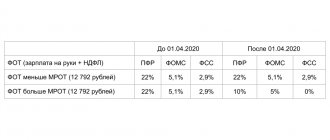General list of taxes and mandatory payments from the payroll
In accordance with Russian legislation, individual entrepreneurs, all enterprises and institutions that hire employees, act as their tax agents and make monthly deductions from the payroll fund.
The employees themselves, that is, individuals, are excluded from the process of transferring taxes. They can only find out about the payment of mandatory payments from a salary “receipt” or a certificate in form 2-NDFL.
This procedure was adopted for the convenience of the federal tax service. It is easier for its employees to control organizations than to deal with each taxpayer separately.
Charges to the wage fund appear monthly.
Charges to the wage fund appear monthly. The task of each employer is to pay them within the period prescribed by law and in full. This list includes:
- Taxes on personal income - on employee wages, sick leave and vacation pay, bonuses and other payments that are transferred to employees based on the results of their professional activities.
- Mandatory transfers to specialized funds - pension, as well as social and health insurance.
Payroll planning
Based on the fact that the wage fund includes a significant share of the company’s total expenses, an important issue is the preliminary (planned) determination of the structure and size of the payroll.
The payroll planning process can be represented by the following algorithm:
- Collect information about the structure of the company, the number of personnel and its movement, data on average salaries, production targets; study the staffing table and internal local acts related to payroll (provisions on wages, bonuses, etc.).
- Predict the average number of personnel for the planned time period.
- Choose a planning structure (decide on the main planning parameters and the level of detail of indicators), draw up an estimate.
- Calculate the payroll, choosing the most acceptable method of calculating it.
Read the internal local acts in the material “Regulations on remuneration of employees - sample 2020”.
The predicted payroll allows for timely analysis and control of its use.
Timely payment of personal income tax for all employees is an important part of payroll payments
The main payroll tax is personal income tax , a tax on personal income. The amount of this tax paid by residents of the Russian Federation - and this includes the majority of employees - is 13% of the total accrual amount.
If the organization’s staff includes a foreign citizen, that is, a tax resident of another state, 30% of the accrual amount is required to be paid to the Russian budget. Such situations occur much less frequently in practice, but they are still worth remembering.
Tax payment is made on the same day as the transfer (issue) of money to the employee. Most often, personal income tax is paid on wages , as well as on vacation pay, sick leave and bonuses. Please note that it is necessary to pay personal income tax on wages only once a month; payment of this tax on the so-called “advance” is not provided.
What is included in the wage fund: its composition and structure in the balance sheet
The wage fund is one of the elements of the payroll, which is the amount of funds expressed in monetary form intended to pay wages to members of the workforce.
The composition of the wage fund, as well as the composition of the payroll in general, largely depends on the intra-company structure and the content of local “salary” acts (provisions on wages, bonuses, etc.). In addition to payments - remuneration for labor (at tariffs and rates), the wages and salaries include bonuses, rewards and incentive payments.
There are 4 main components of the FZP:
- direct salary;
- payment for unworked time (vacation, downtime, etc.);
- incentive payments (bonuses, bonuses for length of service, etc.);
- “supporting” payments (free or partial compensation to workers for food, utilities, fuel, etc.).
The structure of the FZP balance sheet varies from company to company. For example, the structure of the “salary” fund of a small consulting firm may look like this:
Total payroll – 100%, including:
- administration – 35%;
- consultants – 40%;
- accounting – 15%;
- technical personnel – 10%.
With regard to the formula for calculating the payroll, the same algorithms and approaches are used as for calculating the payroll described in the previous section.
The wage fund, like the payroll fund in general, requires a scrupulous and attentive approach, so self-respecting companies regularly draw up estimates of the “salary” fund, and also engage not only in its planning, but also in regular analysis. We'll talk about this further.
Mandatory payments from the payroll to various funds
The law also obliges employers to make monthly several types of mandatory payments for employees in favor of various insurance funds - social and medical. It is also the responsibility of entrepreneurs and organizations to pay pension contributions for all their employees.
Currently, the following rates are provided for these categories of payments (of the total payment amount)::
- health insurance - 5.1%;
- social insurance - 2.9% (may be increased in hazardous and hazardous industries);
- pension contributions - 22%.
Please note that individual entrepreneurs are not required to pay social security contributions ; this category only applies to legal entities. An exception is the situation when an entrepreneur wants to transfer funds to social insurance voluntarily.
The law obliges employers to make monthly several types of mandatory payments for employees in favor of various insurance funds.
Example 2
Revenue is 1000 thousand rubles, costs excluding payroll are 500 thousand rubles, payroll is 100 thousand rubles, insurance premiums are 30 thousand rubles.
The “simplified” tax without taking into account the payroll will be equal to
STS1 = (1000 – 500) x 15% = 75 thousand rubles.
Taking into account payroll
STS2= (1000 - 630) x 15% = 55.5 thousand rubles.
Thus, the tax decreased by 75 - 55.5 = 19.5 thousand rubles.
Total additional fiscal burden due to payroll payments
DN = 30 – 19.5 = 10.5 thousand rubles, or 10.5% of the payroll amount.
Table - all payments and transfers are clear
In order not to get confused in the list of mandatory payments assessed by the state on the wage fund of individual entrepreneurs and legal entities, use the simple and convenient table presented below .
| Tax, contribution or payment | Rate (based on the amount charged) | Some nuances |
| Personal income tax | 13% or 30% | Tax residents of Russia pay personal income tax in the amount of 13%, citizens of foreign countries - 30%. |
| Pension contributions | 22% | Pension contributions are also paid by certain categories of foreign citizens, this is due to the status of their presence on the territory of the Russian Federation. |
| Social insurance contributions | 2,9% | This is a standard rate, which can be increased depending on the harmfulness and danger of production. Paid only by legal entities, individual entrepreneurs - only at will. |
| Health insurance | 5,1% | – |
Russian legislation provides for penalties for non-payment of any taxes and mandatory payments.
How to recalculate payroll
If it is necessary to recalculate an employee’s tariff rate, the program can use the cumulative tariff rate, which allows you to take into account not only the employee’s salary, but also other accruals.
Let’s assume that an employee has been given an accrual in the form of a “Mentoring Bonus.” In this case, payment for holidays and weekends is calculated only from the salary. It is necessary to ensure that the premium is taken into account when calculating and paying them.
To add a premium to the total tariff rate, open the “Settings-Salary Calculation” section and find the indicators responsible for its composition. From the left side of the indicators, select the required allowance and, by pressing “>”, transfer it to the right side of the indicators.
Fig.8 Salary calculation settings
The final update of the total rate will occur only after using the service processing “Payroll Recalculation” in “Salary-Service”.
Fig.9 Navigation of payroll recalculation
Automation of salary and payroll calculations
An integrated approach to salary calculation and KPIs, payroll planning and analysis, convenient analytics in 1C: ZUP
Learn more
Example of calculations and transfers - calculation of payroll and all mandatory payments
Let's look at how the volume of taxes and mandatory payments from the payroll fund is calculated in 2022 using the example of the fictitious organization LLC "Flowers". Let’s assume that the organization employs 18 employees, 16 of whom are tax residents of Russia (that is, they pay 13% personal income tax), and the other 2 are non-residents (that is, 30% personal income tax for them).
The salary of 5 employees is 15,000 rubles (including two foreign citizens), 5 others - 18,000 rubles, 3 - 25,000 rubles, 4 - 30,000 rubles and 1 - 40,000 rubles. No other accruals other than employee wages were made this month. First, we calculate the size of the wage fund for this month:
(5 * 15,000) + (5 * 18,000) + (3 * 25,000) + (4* 30,000) + 40,000 = 400,000 rubles.
At the same time, the total salary of tax residents is 370,000 rubles, and non-residents - 30,000 rubles. Now let’s calculate what and in what amount the employer will pay to the budget and insurance funds:
- Personal income tax of tax residents. 370,000 * 13% = 48,100 rubles.
- Personal income tax of non-residents. 30,000 * 30% = 9,000 rubles.
- Pension contributions. 400,000 * 22% = 88,000 rubles.
- Health insurance premiums. 400,000 * 5.1% = 20,400 rubles.
- Social insurance contributions. 400,000 * 2.9% = 11,600 rubles.
Thus, the total value of all mandatory payments to the budget and insurance premiums for an organization whose monthly payroll amounted to 400,000 rubles will be 177,100 rubles. That is, the cost of paying employees and accompanying accruals will be equal to 577,100 rubles.
How to calculate payroll: formula for calculating the balance
What does the wage fund include and how to calculate it correctly? This question is relevant for all businessmen - the salary component of the cost of goods or services often constitutes a significant share of it and affects the final financial result of the company.
Excessive savings on the payroll amount are fraught - meager salaries, lack of incentives and compensation payments do not contribute to high production indicators and obtaining decent profits. The result of such tight-fistedness of a businessman can be staff turnover, low labor productivity, the desire of individual team members to make up for the amount of remuneration received for work at the expense of the company’s property, etc.
The formula for calculating payroll is the sum of its various components. The number of elements of such a formula depends on the content of internal local acts. For example, if these documents provide for monthly payment to employees of wages (W), bonuses (PR), as well as financial assistance (MA) in addition to vacation pay (WTP), then the formula for calculating the payroll will look like this:
PHOT = Salary + PR + OTP + MP.
The algorithm for calculating the wage fund, the formula of which is presented above, is schematic, and the calculation of the payroll (as well as the calculation of the wage fund) in various companies can be carried out according to a more detailed or abbreviated version of the formula, depending on the composition of the payroll and the wages.
When accounting registers are used as a source of information for the formula, the wage fund for a certain period is calculated as follows. The data on the credit of the 70th account (“Settlements with personnel for wages”) is added from the debit of the accounts:
- the 20th, which reflects operations characteristic of “Main production”;
- 25th, where “General production expenses” are reflected;
- the 26th, reserved for “General business expenses”;
- 08th, where “Investments in non-current assets” are recorded;
- 91st, intended for “Other income and expenses”, etc.
The labor inspector of the State Labor Inspectorate of the Nizhny Novgorod Region, V. I. Neklyudov, explained how to conduct an analysis of the wage fund. Get trial access to ConsultantPlus and find out the official’s point of view for free.
Who should pay
All employers must pay social contributions. That is, organizations and individual entrepreneurs who have hired at least one employee, and individuals who do not have the status of individual entrepreneurs, but make any payments to employees. In addition, this responsibility is assigned to individual entrepreneurs who work for themselves, for example, lawyers, notaries.
Quite often there are situations when one person falls under several categories of insurance premium payers. In this case, insurance contributions must be made on each basis. For example, an individual entrepreneur who has employees. In this case, he pays both for himself and for his employees.








